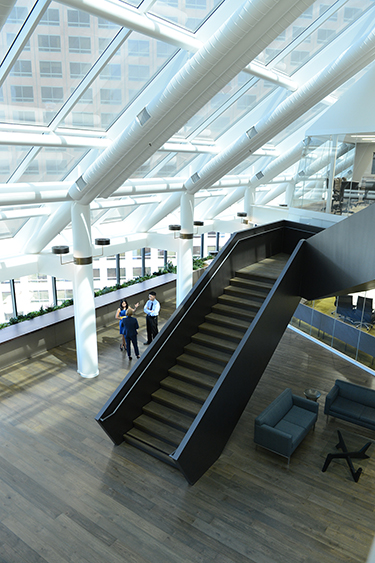|
Subscribe / Renew |
|
|
Contact Us |
|
| ► Subscribe to our Free Weekly Newsletter | |
| home | Welcome, sign in or click here to subscribe. | login |
Real Estate
| |
 Nat Levy Real Estate Reporter |
March 31, 2016
Real Estate Buzz: New green building certification focuses less on structures, more on people who use them
Real Estate Reporter
As demand for green buildings has grown, so has the number of ways to get them certified. LEED is a common standard in this area but that's not the case in every market.
One of the newest certifications is the Well Building Standard, which focuses less on the building itself and more on the health of people inside it. The standard was developed by Delos and the International Well Building Institute, two organizations founded by Paul Scialla. Scialla spent 18 years on Wall Street, including 10 years as a partner at Goldman Sachs.
Delos' website says Scialla wants to promote sustainability and “altruistic capitalism,” and sees these organizations as a way to combine his interest in real estate and personal wellness.
The Buzz sat down with Scialla to talk about what this new approach can do for buildings and people. Answers have been edited for style and length.
Q: What is this new standard?
A: The Well Building Standard is the first building standard to focus exclusively on the health and wellness of the people in buildings. It marries best practices in design and construction with evidence-based medical and scientific research, harnessing the built environment as a vehicle to support human health and well-being.
Q: Why do you think we need it?
A: We spend more than 90 percent of our time indoors, which means that buildings, and everything in them, can have a profound effect on human health and well-being. The conditions buildings create and the activities they support or discourage affect our lives every day. From the quality of the air in a space, to the amount of daylight, to the “walkability” of the location, there are many design, construction and operation decisions that can contribute to a person's wellness within the built environment.
Q: How long have you been working on it?
Well is the product of seven years of research and development consulting, with a three-phase expert peer review process encompassing a scientific, practitioner and medical review. Well v1 was launched in October 2014 by the International Well Building Institute following the completion of the peer review and pilot phase.
Q: How is it different from other certifications?
A: Well is the only building certification standard grounded in medical and scientific research focused exclusively on improving occupant well-being. While leading green building rating systems like LEED began the conversation on human health, Well expands it and builds upon evidence-based research from doctors and scientists.

Q: Is this competing with LEED or other certifications?
A: Well works harmoniously with LEED and the Living Building Challenge, and is expanding alignment with other international leading green building systems like Three Star, Green Star and BREEAM. We welcome projects to pursue both LEED and the Living Building Challenge alongside Well in order to promote both environmental sustainability and human health.
Q: Would Well change design and construction?
A: We believe that buildings should be developed with people's health and wellness at the center of design, as our built environment can shape our habits, regulate our sleep-wake cycle, drive us toward healthy and unhealthy choices, and passively influence our health through the quality of our surroundings. Well provides a framework for project teams to incorporate a variety of strategies to integrate human health and well-being at the heart of building design, construction and operations. Well also allows project teams to innovate and transform the way humans interact with buildings and spaces they live in.
Q: Are there any examples, especially around here?
A: One of the earliest adopters is CBRE Group at its global headquarters in downtown Los Angeles. This is the first commercial office building to achieve Well certification under the Well Building Standard Pilot Program. It uses innovative Well features such as circadian lighting systems to support employees' sleep/wake cycles and promote alertness. The company conducted an employee survey one year post-occupancy, and the results were staggering: 92 percent of respondents reported that the new space created a positive effect on their health and well-being, 94 percent said the new space has had a positive impact on their performance, and 83 percent said that they felt more productive.
| Well events set for next week in Seattle |
|
The Washington Chapter of NAIOP will have a happy hour and introductory session on the Well Building Standard April 4. More information about the event is at: http://goo.gl/Wx5hnm. Then on April 6, the Seattle 2030 District and International Well Building Institute will offer an all-day workshop about the Well standard led by Natasha Frank and Peter Smith of Delos. More information about the event is at: http://goo.gl/XlWA4t.
|
Currently there are a number of projects registered in Northern California, British Columbia and Canada, and we look forward to welcoming projects in Seattle to get Well certified soon. To date, Well has enrolled over 30 million square feet of building projects in 14 countries. Other projects can be found on the Well website at http://www.Wellcertified.com/projects.
Q: How do people get trained?
A: In addition to Well certification, IWBI offers the newly launched Well Accredited Professional program, which focuses on human health and wellness in the built environment and specialization in the Well Building Standard. To become a Well AP, all candidates must pass the Well AP exam. You can learn more about the Well AP credential and register for the exam at Wellcertified.com/Well-ap. IWBI also has resources and publications, educational opportunities and workshops.
Q: Is anyone championing this locally?
A: Well is a global standard. More than 120 projects encompassing more than 30 million square feet have already enrolled in the Well Building Standard on five continents. Delos' partnerships with CBRE, Lendlease, Chinese real estate company Sino-Ocean Land and Arup are also instrumental in Well's global expansion. It has been exciting to see this level of interest, both in the U.S. and internationally.
Q: What does it cost?
A: IWBI fees cover registration, certification and performance verification. Pricing varies not only based on size, but there is also flexibility to include projects of different types. The higher the square footage, the more flexibility is afforded on pricing, providing economies of scale. IWBI's pricing calculator is a useful resource for people who would like a customized quote: https://projects.Wellcertified.com/node/add/pricing.
Q: Why should developers, architects and contractors try Well?
A: A Well-certified project can generate increased savings and productivity, in addition to a meaningful return on investment to the tenant and building owner. By placing people at the heart of design, construction, operations and development decisions, we have the ability to add value to real estate assets, generate savings in personnel costs, and enhance the human experience, health and well-being. Prioritizing Well also provides the opportunity to stand at the forefront of innovation in the sustainable and healthy building movement.
Got a tip? Contact DJC real estate editor Brian Miller at brian.miller@djc.com or call him at (206) 219-6517.
Previous columns:
- Real Estate Buzz: New owners revamp Seattle Design Center, 03-24-2016
- Real Estate Buzz -- OneRent: Startup uses an Uber approach to streamline property management services, 03-10-2016
- Real Estate Buzz: So here's the low down on Luma, which opens in June on First Hill, 03-03-2016
- Real Estate Buzz: This development cycle is in 7th inning, but experts say the game's not over yet, 02-25-2016
- Real Estate Buzz: HAL Real Estate is gearing up for growth, 02-04-2016
- Real Estate Buzz: How long can this boom keep going?, 01-28-2016
- Real Estate Buzz: Onni's massive SLU project still on track, 01-14-2016
- Real Estate Buzz: There's a lot of buzz about the waterfront, 01-07-2016



